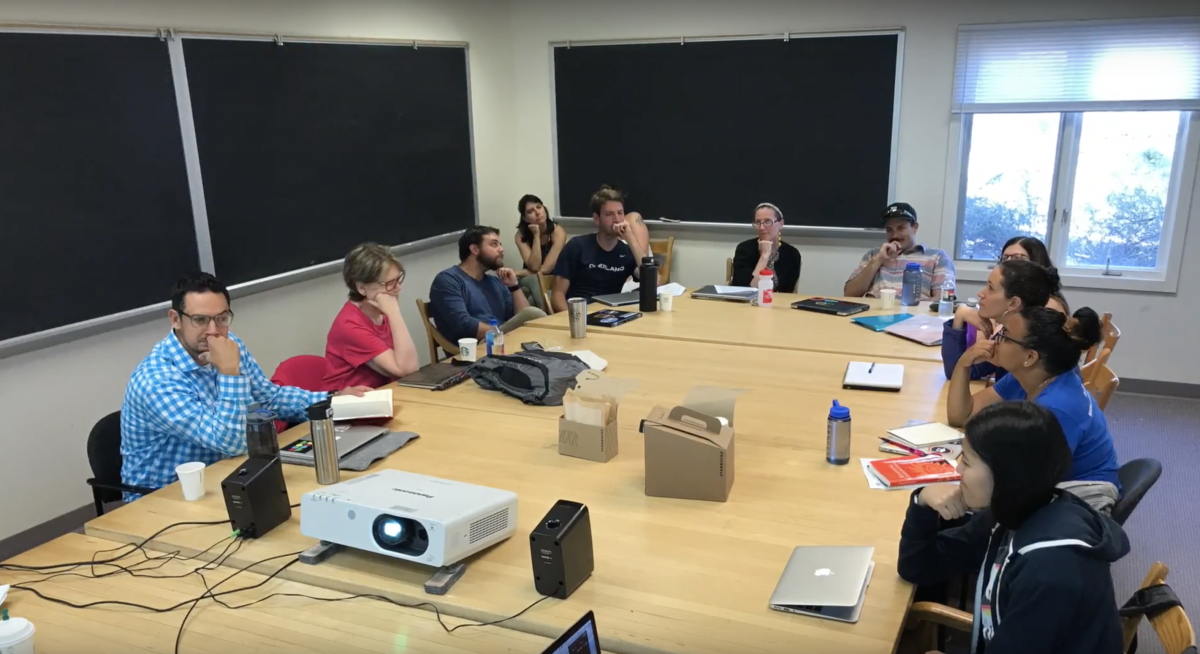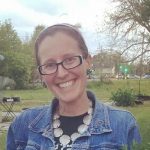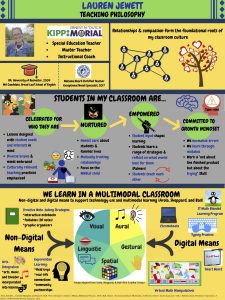Santa Fe Spotlight: Teaching Multimodal Writing in a Digital Age
0February 11, 2019 by Tom McKenna

Dr. Cruz Medina’s students rave about the balance of theory and practical application they experience in his course, Multimodal Composition in a Digital Age. Since the course will once again be offered on the Santa Fe Campus in Summer 2019, I thought it would be fun to interview Cruz about the class, and to highlight the work of several students. During our interview, Cruz takes on the question of why it’s important to give graduate students experience composing in multiple media. He gives insights into how he continuously revises the course in dialogue with students, and how Santa Fe field trips enrich the course through “immersive” aesthetic experiences.
Cruz hits a couple of notes resonating with this issue’s theme of ability and advocacy. He highlights how Lauren Jewett’s presence in last summer’s class drove the group to reflect multimodal composition’s affordances of better access to learning for some students, especially those experiencing disabilities. (See Lauren’s reflection and video below. ) Also, Cruz alludes to several examples of his students creating audiences for their own students’ work—opportunities that allow the students to grow as both composers and as activists. Jei-Jei Tan’s teaching philosophy from the course, featured below, testifies that her students use digital composition to “examine and understand their own and others’ experiences to become motivated and empowered as agents of social change, working towards a more ethical world.” —Tom McKenna
Dr. Cruz Medina, Assistant Professor of Rhetoric and Composition at Santa Clara University, serves on the summer faculty of the Bread Loaf School of English at Santa Fe. This conversation with Tom McKenna took place December 12, 2018.
2018 Student Reflections: Lauren Jewett and Jei-Jei Tan
 Lauren Jewett
Lauren Jewett
Special Education Teacher / Case Manager (4th and 5th Grade)
KIPP Ernest N. “Dutch” Morial School
New Orleans, LA
BLSE Santa Fe
Summer 2018
In Multimodal Writing in a Digital Age, I learned several useful strategies that I can apply to my teaching practice and pedagogy. Even though the class specifically emphasized how to use technology and digital means to write and compose texts, I felt that the class was extremely flexible in its approach to everyone’s different teaching situations and environments. The course covered an array of skills and techniques that I am excited to implement with my colleagues and students. We learned how to build a website where we wrote bi-weekly blog posts on our readings. We also read an article that discussed the ways we can make our hand-outs and syllabi more accessible for all learners.
As a special education teacher, I can share this kind of information with my colleagues to help not only the students I directly work with, but students in other classes in my school building. The main assignments in this Bread Loaf course included creating an alphabetic (written) teaching philosophy statement, then remediating this statement into a visual infographic, and then making a digital video teaching philosophy. I plan to use my infographic and digital video teaching philosophy as tools at the beginning of the school year that I can share with my fellow teachers, administrators, parents, and students. These will help communicate and articulate my teaching beliefs and values in a clear, concise, and engaging way.
In my classroom, I have typically shied away from taking extra initiative to use technology or digital activities with my students. Technology is not always available or reliable. At the end of my 2017-2018 school year, however, I made a commitment to improve my use of technology in the classroom. I knew that my excuses of “the technology isn’t working” or “I don’t have enough Chromebooks for this digital activity” were not enough for me to avoid technology forever. Moreover, I knew that technology would provide important avenues of accessibility and differentiation to ensure success for ALL of my students.
After taking Multimodal Writing in a Digital Age, I felt inspired to try new technology strategies with my students across collaborative projects during the 2018-2019 school year. I specifically aimed to increase my students’ technology use as part of my current Bread Loaf Teacher Network project. Fellow Bread Loaf Teacher Network member Hillary Howard, a high school English teacher at East Jessamine High School in Kentucky, and I have been working in partnership this school year to do an exchange with our students. In this project, we intend to help students develop their own agency, advocacy, and voices as learners and members of educational communities.
So far, my students have learned how to utilize Google Docs and accompanying tools on this platform to edit and revise their typed letters and to add images to supplement their written words. For the upcoming second semester, Hillary and I will implement alternative ways for our students to express their thoughts and ideas beyond the handwritten or typed letter. Many of my students are continuing to improve their written expression, fine motor, and handwriting skills and currently receive specialized services to address these areas, but I am always looking for ways to leverage their strengths and assets and help build their self-confidence as learners. A strength I observe in many of my students is their verbal expression skills—they can tell detailed stories and create original songs and raps about learning content with excitement and ease. Using my knowledge of my students’ strengths and the skills gained from Cruz’s class, I plan to work with Hillary so that our students can create video learning logs and digital essays and use Flipgrid video messages and Google Hangout as part of their dialogue. We intend for these activities to help reduce any anxiety, fear, or disinterest that students have around strict pencil and paper writing activities by demonstrating to them that they can use different and engaging media to communicate their ideas and opinions to people.
By taking our students on a journey of learning in and out of their own classroom and with new students and new places, we hope to show students that the classroom is not defined by the walls of the school building. Rather, the community and the relationships that exist within it can serve as classrooms and laboratories of learning themselves.
 Jei-Jei Tan
Jei-Jei Tan
Upper School English Teacher
Taipei American School
BLSE Santa Fe
Summer 2018
When I started teaching, many of my assessments, activities, and even my teaching style were modeled after other teachers’. I had thoughts and conversations about pedagogy, but never formally articulated a cohesive set of ideas that could guide me in the classroom. Taking Teaching Multimodal Writing in the Digital Age with Cruz Medina helped me to reflect on my own practices and to begin developing my teaching philosophy. Through thought-provoking readings, class discussions, and multimodal assignments, I considered both my long- and short-term goals as an English teacher.
I wanted to be more intentional about having students study and produce diverse texts. This year, we have analyzed media including print and video advertisements, websites, and opinion columns, paying particular attention to how their language and multimodal features persuade audiences. Students have also delivered oral presentations that demonstrate their knowledge through a combination of modes and technologies, and they have produced their own articles and opinion columns that consider visual elements in addition to alphabetic writing. Since we are surrounded by such multimodal texts in our everyday life, my students are learning to be more active, aware, and critical readers of their environments.
Category Campus News, Featured, Winter 2019 | Tags:

Leave a Reply